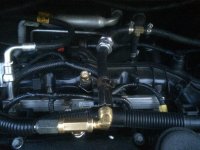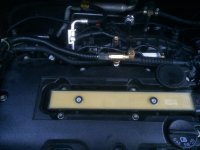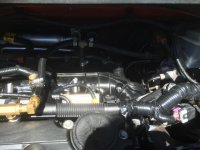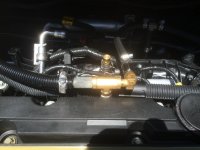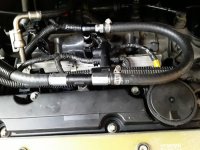zomby woof
Member
I haven't been on here in some time so if somebody's already come up with this solution then just ignore the thread, but I think it's a lot cheaper and easier than the one that was popular the last time I looked into it.
THE INTAKE DOES NOT HAVE TO COME OFF - that's the sole idea behind this method, and you should be able to get all the parts for about $20 or so.
What you need:
EDIT: I've found that some of the aftermarket PCV valves don't seal well. So in addition to the PCV valves, I have added a small inexpensive check valve between the intake and the valve cover, such that it will open with vacuum, and close on boost. Something like this is what I'm using
Two PCV valves from a Hyundai Accent. The same valve was used in a lot of Hyundai and Mitsubishi applications, but I took mine from Accents in the local wrecking yard - you will have to cut the brass tube off on the threaded end.
This is the part:
https://www.rockauto.com/en/catalog...v+(positive+crankcase+ventilation)+valve,5052
You will also need some fittings
One 1/8" NPT Tee
One 1/8" NPT nipple
One 1/8" NPT 90 degree street elbow fitting
One 5/16 barb tee.
One 1/8" brass coupler (must be 14mm OD - more on this later)
One 1/8" pipe plug
Four hose clamps
A foot or so of 5/16" hose
Remove the valve cover and drill the top boss area that's over the port from the cylinder head that allows the gasses to go into the intake for a 1/8" NPT thread and tap it.
Install the Tee and PCV valves like in the pic. Be careful because the plastic is thin and it will be easy to pull the threads out. You can use pipe dope, teflon tape or nothing if you prefer.
While the valve cover is off, plug the port from the cylinder head.
You can use a piece of steel or aluminum rod that fits tight (or grind a piece to fit tight) and some epoxy or just cut a small piece of aluminum or sheet metal just big enough to cover the port. I used residential flashing material because I had lots and it was easy, and I epoxied mine down. The valve cover gasket should be flexible enough to still seal over the sheet metal, just make sure you use something thin enough.
EDIT: If you read the other posts another member plugged the valve cover side instead of the head itself. That may be a better solution. Do whichever you feel comfortable with
Remove the fittings from the vac port coming out the intake and replace them with the hose and Tee like in the pic. Run one from the Tee to the PCV valve on the Street el pointed back
Remove the corrugated looking hose from the intake and cut the shrink tube and pull the barb out of it. You can also cut the barb and hose section off because it's long enough to reach the tee/PCV. Put a short piece of 5/16" hose on the PCV outlet pointing to the passenger side and slip the corrugated hose over it. I originally thought a clamp was not needed here, but I eventually used one because mine started to weep a little after a while without it.
To plug the port that the corrugated hose goes on, you need something 14 mm diameter. You can see in the pic that I used the 1/8" brass NPT pipe coupler. I was going to machine a plug out of aluminum, but this is working so it's not a priority.You can use almost anything as long as it's the correct diameter, or you could also reuse the barb that came off and plug it by using a piece of hose and a pipe plug/bolt and hose clamp.
Make sure to use a hose clamp on anything on the intake side of the system as it will see boost pressure.
I will add more info and get better pics as questions arise and/or I realize I forgot something.
NOTE:
The silver check valve that you see on the intake side is not required, I was just checking it to see if it would hold up. It has so far, but the one I tried originally did not hold up to boost pressure. It was my first idea, and an alternative to the Hyundai PCV valve, but IMO, the PCV valve is far more robust and should last indefinitely.
THE INTAKE DOES NOT HAVE TO COME OFF - that's the sole idea behind this method, and you should be able to get all the parts for about $20 or so.
What you need:
EDIT: I've found that some of the aftermarket PCV valves don't seal well. So in addition to the PCV valves, I have added a small inexpensive check valve between the intake and the valve cover, such that it will open with vacuum, and close on boost. Something like this is what I'm using
Two PCV valves from a Hyundai Accent. The same valve was used in a lot of Hyundai and Mitsubishi applications, but I took mine from Accents in the local wrecking yard - you will have to cut the brass tube off on the threaded end.
This is the part:
https://www.rockauto.com/en/catalog...v+(positive+crankcase+ventilation)+valve,5052
You will also need some fittings
One 1/8" NPT Tee
One 1/8" NPT nipple
One 1/8" NPT 90 degree street elbow fitting
One 5/16 barb tee.
One 1/8" brass coupler (must be 14mm OD - more on this later)
One 1/8" pipe plug
Four hose clamps
A foot or so of 5/16" hose
Remove the valve cover and drill the top boss area that's over the port from the cylinder head that allows the gasses to go into the intake for a 1/8" NPT thread and tap it.
Install the Tee and PCV valves like in the pic. Be careful because the plastic is thin and it will be easy to pull the threads out. You can use pipe dope, teflon tape or nothing if you prefer.
While the valve cover is off, plug the port from the cylinder head.
You can use a piece of steel or aluminum rod that fits tight (or grind a piece to fit tight) and some epoxy or just cut a small piece of aluminum or sheet metal just big enough to cover the port. I used residential flashing material because I had lots and it was easy, and I epoxied mine down. The valve cover gasket should be flexible enough to still seal over the sheet metal, just make sure you use something thin enough.
EDIT: If you read the other posts another member plugged the valve cover side instead of the head itself. That may be a better solution. Do whichever you feel comfortable with
Remove the fittings from the vac port coming out the intake and replace them with the hose and Tee like in the pic. Run one from the Tee to the PCV valve on the Street el pointed back
Remove the corrugated looking hose from the intake and cut the shrink tube and pull the barb out of it. You can also cut the barb and hose section off because it's long enough to reach the tee/PCV. Put a short piece of 5/16" hose on the PCV outlet pointing to the passenger side and slip the corrugated hose over it. I originally thought a clamp was not needed here, but I eventually used one because mine started to weep a little after a while without it.
To plug the port that the corrugated hose goes on, you need something 14 mm diameter. You can see in the pic that I used the 1/8" brass NPT pipe coupler. I was going to machine a plug out of aluminum, but this is working so it's not a priority.You can use almost anything as long as it's the correct diameter, or you could also reuse the barb that came off and plug it by using a piece of hose and a pipe plug/bolt and hose clamp.
Make sure to use a hose clamp on anything on the intake side of the system as it will see boost pressure.
I will add more info and get better pics as questions arise and/or I realize I forgot something.
NOTE:
The silver check valve that you see on the intake side is not required, I was just checking it to see if it would hold up. It has so far, but the one I tried originally did not hold up to boost pressure. It was my first idea, and an alternative to the Hyundai PCV valve, but IMO, the PCV valve is far more robust and should last indefinitely.
Attachments
Last edited:

